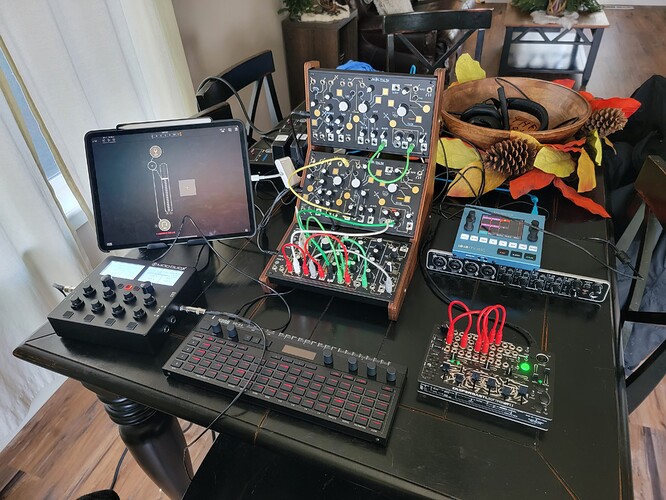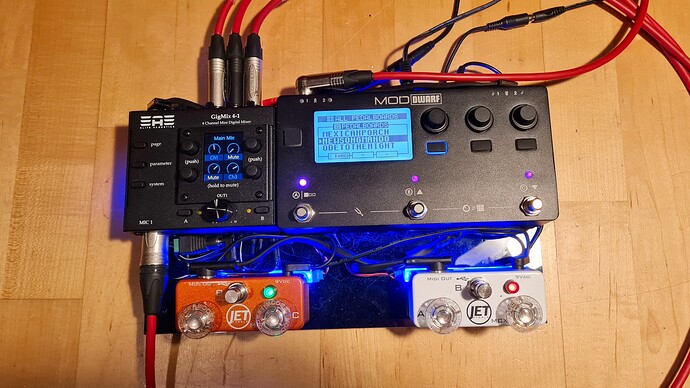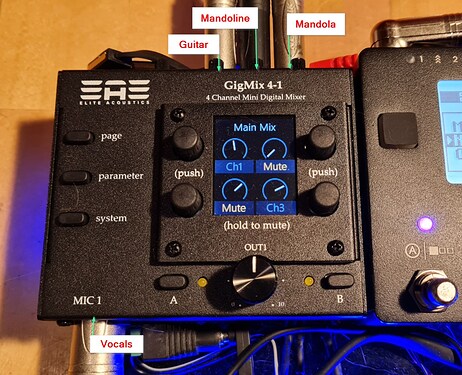My reduced physical pedalboard has now changed once again. The reason for this was another instrument that came along, I now play not only mandolin and guitar more, but also mandola. As already described, one of the instruments and, in parallel, my vocals are always connected to the Dwarf. I use the two channels of the Dwarf as mono inputs, one for the instruments, the other for the vocals.
Until now, when I changed instruments, I unplugged the cable (with silent plug) from one instrument and plugged it into the other. That takes some time at the gig which is of disadvantage. In addition, my Duesenberg guitar has a very high input level, while my mandolin with its transducer pick-up has a very low one. So if I forgot to change the pedalboard in the Dwarf when changing instruments and I played even only one string on the guitar, the audience’s ears flew away  . I also always had problems with gain staging and keeping the volume the same for guitar and mandolin.
. I also always had problems with gain staging and keeping the volume the same for guitar and mandolin.
To make matters worse, there now was a third instrument, which again behaved quite differently. A solution was needed. And this is how the new pedalboard looks with this solution. It still fits into the bag of my gig bag, which I use to transport guitar and mandolin.
I bought a small digital mixer in pedalboard format, the GigMix 4-1 from Elite Accoustics. This one is fitting 100% to my needs, it has 4 channels, it is very small and light and it has no foot-switsches (I don’t need them). There is even another available with foot-switches the StompMix, just for your information.
The GigMix is not even half the size of the Dwarf and has 4 channels. The small mixer can do just as much as a conventional mixer, plus it has a delay that can be applied to any of the 4 channels and a reverb (even with a nice adjustable shimmer) that can be applied to all channels at the same time. I have now connected all four sound generators, three channels are switched to one output of the mixer, one channel to the other, one goes into one channel of the Dwarf, the other to the other.
The nice thing is that I can now plug three instruments and the vocals at once in the Dwarf, perfectly matched to each other. The Dwarf is still the only sound-shaping device on the pedalboard, the other devices help with routing, switching etc.
The observer may notice that two midi controllers are now connected. I did this because, as a busy guitarist and singer, I need to be able to operate the pedalboard as easily as possible, especially during a gig. And above all I can’t reprogram the Dwarf’s footswitches (the handling is too complicated and too risky to accidentially do something wrong in a gig in my eyes… and this happend already sometimes). The left midi controller is now used for switching the pedalboards upwards and downwards and to mute the Dwarf. The right one influences the sound: I can switch snapshots, fire my “Endless Decay” and do a few other sound-technical nice tricks  . So now I don’t even use the foot-switches of the Dwarf any more, only the foot switches of the two Midi controllers.
. So now I don’t even use the foot-switches of the Dwarf any more, only the foot switches of the two Midi controllers.


 I saw it yesterday on Youtube, but just thought “holy s**t! 1h+ video?! I can’t do it now!”
I saw it yesterday on Youtube, but just thought “holy s**t! 1h+ video?! I can’t do it now!”






